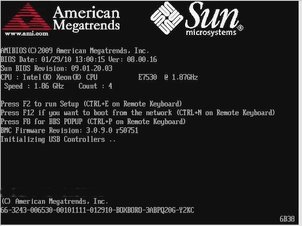| Skip Navigation Links | |
| Exit Print View | |

|
Sun Server X2-4 (formerly Sun Fire X4470 M2) Installation Guide for Oracle Solaris Operating System |
| Skip Navigation Links | |
| Exit Print View | |

|
Sun Server X2-4 (formerly Sun Fire X4470 M2) Installation Guide for Oracle Solaris Operating System |
Supported Oracle Solaris Operating Systems
Oracle Solaris Documentation Collection
Oracle Solaris 10 and 11 Installation Programs
Installing Oracle Solaris 10 or 11 OS Using Local or Remote Media
Install Oracle Solaris 10 or 11 OS Using Local or Remote Media
3. Getting Server Firmware and Software
Firmware and Software Access Options
Available Software Release Packages
Accessing Firmware and Software
Download Firmware and Software Using My Oracle Support
Installing Hardware Drivers and OS Tools
A. Supported Installation Methods
B. BIOS Defaults for New Installations
Verification of BIOS Factory Defaults
View or Edit BIOS Settings for New Installations
The following procedure describes how to boot the Oracle Solaris 10 or 11 Operating System installation from a PXE network environment. It assumes that you are booting the installation media from one of the following sources:
Oracle Solaris 11 11/11 installation media
Oracle Solaris 11 11/11 ISO boot image or Automated Installer image installation media
Oracle Solaris 10 9/10 DVD set (internal or external DVD)
Oracle Solaris 10 9/10 ISO boot image or Solaris JumpStart image installation media
Note - Automated Installer and JumpStart automate many of the manual tasks of installing and configuring the Oracle Solaris Operating System for the first time on multiple servers. For more information about using a JumpStart image, see the Solaris 10 9/10 Installation Guide: Custom JumpStart and Advanced Installations. For more information about using Automated Installer, see Installing Oracle Solaris 11 Systems.
The following requirements must be met prior to starting the Oracle Solaris 10 or 11 PXE installation:
To use PXE to boot the installation media over the network, you should have completed the following tasks:
PXE boot install server setup to export the installation.
Sun Server X2-4 MAC network port address configured as a client system on the PXE boot install server.
For further information about setting up and installing Oracle Solaris 10 from the network, see the Solaris 10 9/10 Installation Guide: Network-Based Installations. For further information about setting up and installing Oracle Solaris 11 from the network see Installing Oracle Solaris 11 Systems: Installing Using an Install Server.
If your install media source is an Automated Installer or a JumpStart installation image, the image must be properly prepared and ready for installation. Information concerning how to properly set up and deploy an Automated Installer or JumpStart installation is outside the scope of this guide.
For details about creating an Oracle Solaris JumpStart image, see the Solaris 10 9/10 Installation Guide: Custom JumpStart and Advanced Installations. For details about creating a custom Oracle Solaris 11 installation image see Creating a Custom Oracle Solaris 11 Installation Image.
After completing the following procedure, you should review and perform the required post installation tasks described later in this chapter. For more details, see Post Installation Tasks.
For details, see Before You Begin.
Note - The following steps use Oracle ILOM 3.1 command syntax. If you are using Oracle ILOM 3.0, refer to the Oracle ILOM 3.0 Documentation Collection at http://www.oracle.com/pls/topic/lookup?ctx=ilom30.
For example:
The BIOS screen appears.

Note - The next events occur very quickly; therefore, focused attention is needed for the following steps. Please watch carefully for these messages as they appear on the screen for a brief time.
The Please Select Boot Device menu appears.
The PXE boot port is the physical network port configured to communicate with your network install server.
The GRUB menu appears. The sample screen that follows reflects the Oracle Solaris 11 PXE GRUB menu during an Automated Installer installation. The GRUB menu on your system will be different if you are installing Oracle Solaris 10.
GNU GRUB version .97 (639K lower / 2078660K upper memory) Oracle Solaris 11 11/11 Text Installer and command line Oracle Solaris 11 11/11 Automated Install
Note - The default GRUB menu entry, Text Installer and command line, boots the image without starting a hands free installation. Refer to the Oracle Solaris 10 or 11 documentation for further information about this option.
For example:
The system loads the Solaris disk image into memory. This process can take several minutes. When it completes, the Install Type menu appears.
From the Install Type menu, use the up and down arrow keys to select the type of interface that you want to use to perform the installation, and press Enter.
Note - In the GRUB menu, if you want to redirect the install output to a serial console, press “e” to edit the GRUB menu. To support a serial console, append ,console = ttya to the boot flags on the kernel line.
After the installation completes, the system will automatically reboot (if you previously selected this option during the configuration procedure) and will display the Oracle Solaris login prompt.
Note - If you did not configure the system to automatically reboot when the installation completes, you must manually reboot the system.